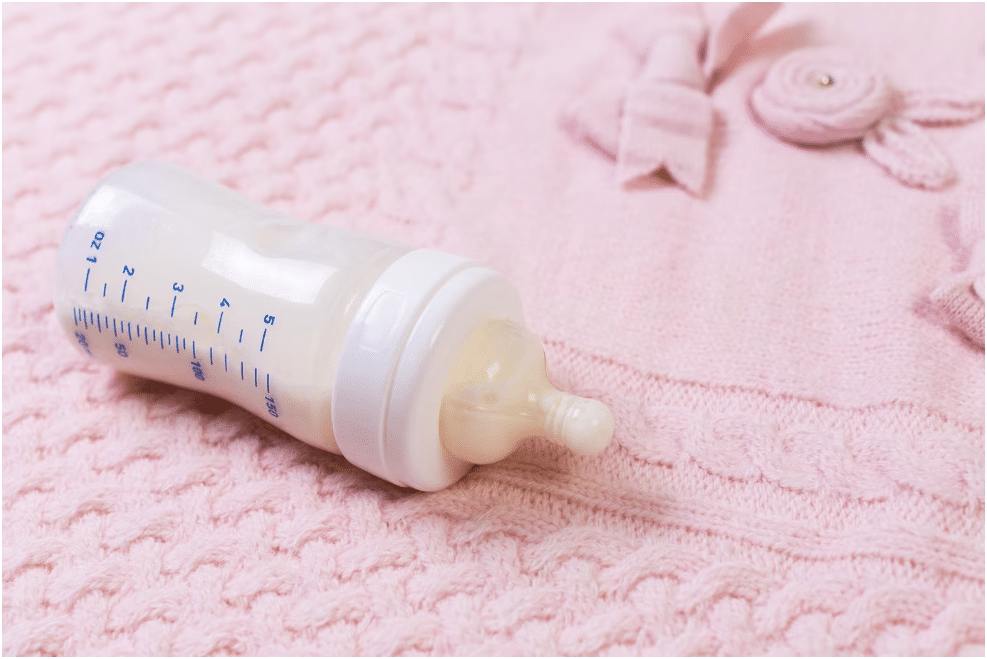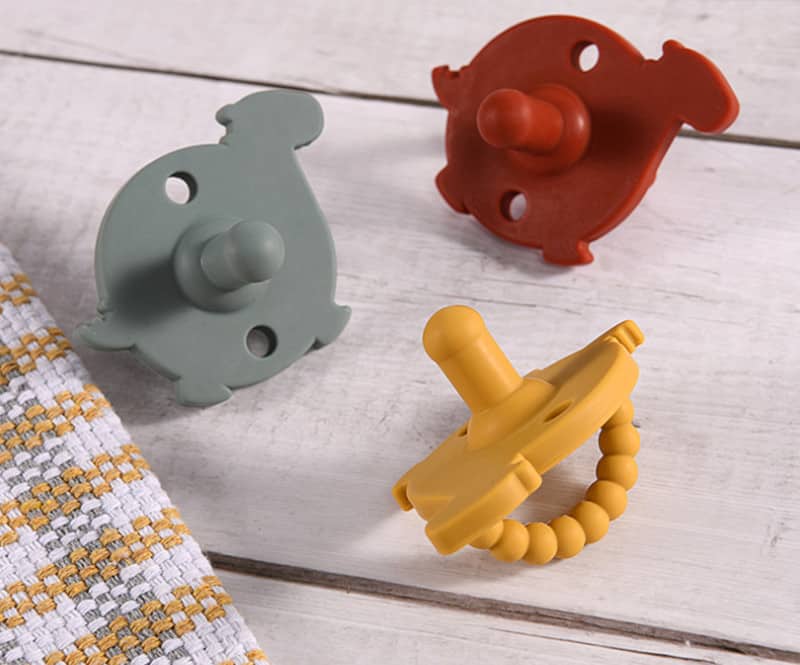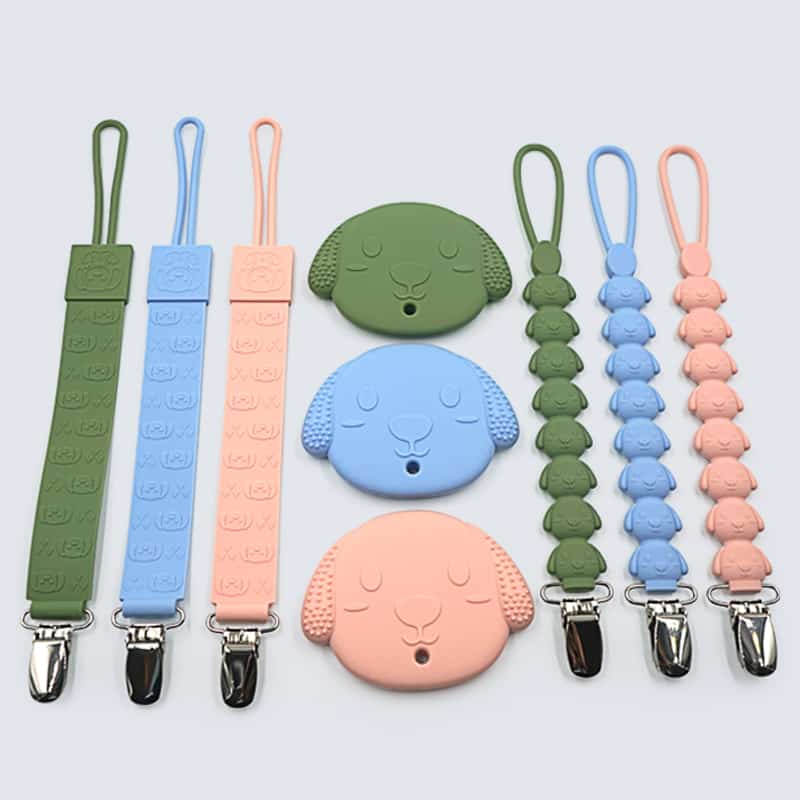How To Label Silicone Pacifier?
Introduction
What is silicone pacifier?
A silicone pacifier is a nipple-shaped object designed to imitate a nipple. It is usually made of silicone and other materials and is intended to soothe the baby’s emotions and satisfy the sucking needs.
The Benefits of Silicone Pacifiers?
Emotional comfort: Silicone pacifiers can quickly meet babies’ sucking needs and help them calm down when they cry.
Sleep aid: Using a pacifier before bed can help babies fall asleep faster and improve sleep quality.
Reduce risk: Studies have shown that using a pacifier can reduce the risk of sudden infant death syndrome (SIDS). Satisfy oral needs: During the oral stage, babies have a strong desire to suck, and pacifiers can meet this need and prevent babies from sucking their fingers or other unhygienic objects.
Anxiety relief: For babies who are prone to anxiety or tension, pacifiers can provide a sense of security and help them relieve anxiety.
Promote oral development: Proper use of pacifiers can stimulate the baby’s oral muscles and help the normal development of the mouth and teeth.
Assisted medication treatment: In some cases, pacifiers can be used as an auxiliary tool to help babies swallow medication more smoothly.
Labeling silicone pacifiers is crucial for ensuring the safety and well-being of infants. According to the U.S. Consumer Product Safety Commission (CPSC), pacifiers were associated with over 2,000 emergency department visits in 2019 alone. These visits were largely due to pacifiers breaking or coming apart, posing a choking hazard to babies.
In light of this, labeling pacifiers with important information such as age recommendations and safety warnings is essential to reduce the risk of harm.
This article will discuss the required information for labeling silicone pacifiers, different labeling techniques, regulations governing labeling, and tips for effective labeling to ensure the safety of infants.
Required Information for Labeling
To ensure the safety of infants, there are several pieces of mandatory information that should be included on the label of a silicone pacifier. These include the name and address of the manufacturer, date of manufacture, lot number or batch code, and age recommendation.
Additionally, it is required to have a warning statement that informs parents or caregivers of the potential choking hazard associated with pacifiers. This warning should include a statement advising caregivers to inspect pacifiers regularly for signs of wear and damage and to replace them as necessary.
According to the CPSC, the warning should be in a font size of at least 3 millimeters and should be easily readable. It is also recommended to include the material composition and cleaning instructions on the label. By providing this information, parents and caregivers are better equipped to make informed decisions about the safety and appropriate use of the pacifier.
Labeling Techniques
There are several labeling techniques available for silicone pacifiers. One common method is the use of adhesive labels, which can be easily printed and applied to the pacifier. Another technique is direct printing, which involves printing the required information directly onto the surface of the pacifier. Laser engraving and embossing are also popular methods that can create permanent, long-lasting labels on the pacifier.
Each of these techniques has its advantages and disadvantages, depending on factors such as the intended use of the pacifier, the desired level of durability, and the production volume.
Adhesive Labels
Adhesive labels are a popular and cost-effective way to label silicone pacifiers. These labels can be easily printed with the required information and applied to the pacifier. They are flexible, can be customized to any design, and can be removed and replaced if needed. However, adhesive labels may not be as durable as other labeling techniques and can easily be removed or damaged with frequent use.
Direct Printing
Direct printing involves printing the required information directly onto the surface of the silicone pacifier. This technique provides a clear, high-quality label that is durable and long-lasting. The printed information is less likely to fade or rub off with use, making it a preferred option for pacifiers that will see heavy use. However, direct printing may require specialized equipment and can be more expensive than other labeling techniques.
Laser Engraving
Laser engraving involves using a laser to burn the required information directly onto the surface of the silicone pacifier. This technique provides a permanent label that is highly durable and resistant to wear and tear. Laser engraving is also less likely to harbor bacteria than other labeling techniques, making it a popular choice for pacifiers that will be used by multiple babies. However, laser engraving may be more expensive than other labeling techniques and requires specialized equipment.
Embossing
Embossing involves pressing the required information into the surface of the silicone pacifier, creating a raised design. This technique provides a permanent label that is highly durable and resistant to wear and tear. Embossing can also provide a unique tactile experience for babies, making it a popular choice for silicone pacifiers. However, embossing may be more expensive than other labeling techniques and requires specialized equipment.
By choosing the appropriate labeling technique, manufacturers can ensure that the pacifiers are clearly labeled and meet the necessary safety requirements.
Custom Silicone Pacifier Clip
Custom Silicone Pacifier
Labeling Regulations
The labeling of silicone pacifiers is governed by regulations to ensure the safety of infants. The U.S. Consumer Product Safety Commission (CPSC) requires that all pacifiers sold in the United States meet certain labeling requirements. These requirements include the inclusion of mandatory information on the label, such as the name and address of the manufacturer, date of manufacture, lot number or batch code, and age recommendation. Additionally, pacifiers must include a warning statement that informs parents or caregivers of the potential choking hazard associated with pacifiers. The warning statement should be in a font size of at least 3 millimeters and easily readable.
Manufacturers must also comply with the labeling requirements of other regulatory bodies such as the European Union, which requires pacifiers to be labeled with the CE mark. The CE mark indicates that the pacifier meets European safety standards.
Non-compliance with labeling regulations can result in fines, product recalls, and legal action. Manufacturers are responsible for ensuring that their silicone pacifiers are labeled correctly and meet all necessary safety requirements. By complying with these regulations, manufacturers can ensure the safety of infants and build trust with their customers.
Labeling Tips
Technical Related
About Author: Z.S.R International Group
Z.S.R International Group(Hong Kong) co., Limited, is a one-stop supplier for molded silicone products and silicone products molding solution provider in the consumer products field. We offer OEM services from silicone product design to Silicone products contract manufacturing. We have the capability for custom silicone tooling, LSR(Liquid silicone Rubber) molded silicone products, solid silicone molded products, molded silicone multi-colored products. We also can custom molded silicone, custom molded LSR, custom molded dripping injection dispensing(co-injection) silicone multi-colored products.




